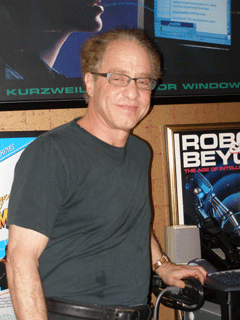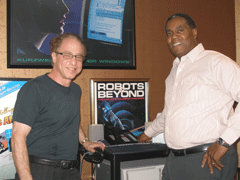The Future of Artificial Intelligence
Air Date: Week of January 11, 2008

Ray Kurzweil (Photo: Dennis Foley)
In the first of a two-part conversation, host Steve Curwood sits down with famed inventor and futurist Ray Kurzweil to look at some of his inventions and discuss the future of artificial intelligence. Kurzweil says that "the singularity" is near - a time when we will merge with our technologies, and greatly expand our human potential.
Transcript
CURWOOD: It’s Living on Earth. I’m Steve Curwood.
[MUSIC: Herbie Hancock: “Tell Me A Bedtime Story” from The Essential Herbie Hancock (Legacy records 2007)]
CURWOOD: If you think that computers and machines have taken over your life—just wait! Ray Kurzweil says soon we'll be married—literally.
Ray Kurzweil is one of the foremost inventors of our age and he says the fusion of man and machine is imminent. He calls it ‘the singularity.’
RAMONA: Raymond has invented many things. Like that reading machine for the blind. Oh, and me.
CURWOOD: That's Ramona—an example of AI, artificial intelligence, and the hostess of Ray's website. We joined him in his Kurzweil Technologies office outside of Boston to talk about his theories and predictions and meet some of his brainchildren.
Ray Kurzweil invented the first text-to-speech reader for the blind back in 1976. It was the size of a small washing machine and the sound technology was still in its infancy.
BLIND READER: Scanner moving to top of page. Four score and seven years ago our fathers brought forth upon this continent a new nation conceived in liberty and dedicated to the proposition that all men are created equal...

Ray Kurzweil and Steve Curwood (Photo: Dennis Foley)
TRANSLATING TELEPHONE: The rain in Spain, (French translation), stays mainly in the plains (French translation).
[MUSIC: All music was performed on the Kurzweil K250 from various online sources including Keyboard Museum.org/soundsheet/k250, Jane Brockman: Kurzweil Etudes (Janebrockman.com), Steven Johannesson: Minuttish (Rude Boys Music, http://www.middleofnowhere.com/music_archive.asp) ]
CURWOOD: Perhaps the most familiar invention to bear the Kurzweil name is the synthesizer that's capable of recreating virtually all the orchestral instruments. In fact all the music you hear in this story was created using the Kurzweil 250.
[MUSIC: Kurzweil K250]
CURWOOD: But what excites him most is what he sees over the horizon now. What he calls 'the singularity.' And what does he mean by that?
KURZWEIL: Well, it primarily refers to our merging with our technology and greatly expanding our human potential. Literally the word refers to a profound transformation. And here we’re using it in a context of human history, in that there will be a great transformation of human society. I put it around twenty forty-five. Where we will greatly expand our capabilities by merging with our technology. And to be a little more specific, by the late twenty-twenties we’ll have both the hardware and the software to create machines that are at human levels of intelligence. We’ve already modeled and simulated twenty different regions of the brain. And we can test those simulations and they perform equivalently to human performance of those brain regions. And the hardware will be quite capable of actually being much more powerful than the human brain.
CURWOOD: So you’re saying in the next twenty-five years—
KURZWEIL: Right.
CURWOOD: The machines will be as smart as we are?

The original text-to-speech reading machine (far left) for the blind and a version of Kurzweil's synthesizer (far right.) (Photo: Dennis Foley)
CURWOOD: For example?
KURZWEIL: Well every time you send an email or connect a cell phone call, intelligent algorithms read the information. Intelligent software flies and lands airplanes, guides intelligent weapons systems, automatically diagnoses electro-cardiogram signals, blood cell images, and I could go on.
If all the intelligent software, and by intelligent software I mean software doing things that used to require human intelligence, were to stop tomorrow, our modern infrastructure would grind to a halt. And that was not true twenty years ago. These projects I just mentioned were research projects twenty years ago.
[MUSIC: Kurzweil K250]
KURZWEIL: The first industrial revolution we extended the reach of our muscles so we can build skyscrapers and so on. And now we’re expanding the reach of our minds and we routinely every day do things that would be impossible without these brain extenders. So we’re routinely expanding our intelligence with our machines today.

The modern, handheld, text-to-speech reading machine for the blind. (Photo: Dennis Foley)
KURZWEIL: We're going to ultimately merge with this technology. And the way we’re going to do that is by getting closer and closer to it. The first computers were very remote. Now they’re in our pockets. They’ll make their way into our clothing. There already are many of these examples of these machines going inside our bodies and brains. If you have Parkinson’s Disease you can have a pea-sized computer put in your brain that actually performs a function of that brain region that was destroyed by the disease. And the latest generation of this FDA-approved neural implant for Parkinson’s Disease, allows you to download new software to your neural implant from outside the patient.
This technology’s not moving along at a slow pace. It’s moving at an exponential pace. And one of my key points is that we’re doubling the power, as measured by price performance and capacity, of information technology every year.
[MUSIC: Kurzweil K250]
CURWOOD: Incredibly fast and incredibly tiny. And soon, says Ray Kurzweil, we'll have robots the size of blood cells—nanobots!
KURZWEIL: So, my vision of what life will be like in the late twenty-twenties, is we will have millions of these nano-bots inside our blood stream. They’ll be keeping us healthy from inside, repairing DNA errors, removing debris, killing cancer cells, augmenting the immune system.

Ray Kurzweil (Photo: Dennis Foley)
They’ll go inside our brains, through the capillaries, non-invasively. Unlike today’s neural implant for Parkinson’s, it won’t require surgery. And it can then actually extend our mental functioning. One thing it can do, for example, is provide full-emersion virtual reality from within the nervous system. So, if we want to go into virtual reality, the nanobots shut down the signals coming from your real sensors, replacing them with the signals that your brain would be receiving if you were in the virtual environment. Then your brain feels like it’s in that environment. You go to move your hand, it moves your virtual hand. Design of new virtual environments will be a new art form. But mostly it’s going to actually extend human intelligence, which arguably computers do today even if most of them are not yet inside our bodies and brains.
CURWOOD: So you must have loved the movie “The Matrix.”
KURZWEIL: Well, “The Matrix” was a cool movie. And that kind of virtual reality will be feasible. You know a lot of these movies paint the future in dystopian terms. And the technology has sort of a sinister feel to it. You know the telephone is virtual reality. You and I can be in the same virtual space even if we’re hundreds of miles away, at least as far as talking is concerned. Well, we’ll add the other senses. The visual sense we can already do in primitive ways. But we’ll actually have full emersion virtual reality involving all the senses. But it’ll be like a telephone, it just won’t be restricted to the auditory sense. It’s not necessarily going to be a kind of sinister thing that we see in the science futurism movies.
[MUSIC: Kurzweil K250]
CURWOOD: What's the one thing that really grabs you as you look ahead?
KURZWEIL: We're going to dramatically change what it means to be human and there are already debates as to what does it mean to be human. In my mind being human means incorporating our technology that we have. It always has. We are the human-machine civilization. We're the only species that creates technology—that’s really what's unique about human beings.
[MUSIC: Kurzweil K250]
CURWOOD: Ray Kurzweil is a futurist and inventor, author of "The Singularity Is Near: When Humans Transcend Biology." This was the first of a two-part conversation we'll have with him. Next time we’ll hear how to hear how he says our new marriage with our technology will radically extend our lives.
KURZWEIL: People say ‘well, if you live hundreds of years, it would get very boring,’ and that's actually true if we didn't also have radical life expansion with the radical life extension. We can expand who we are physically and mostly mentally by putting these nanobots inside our brain and expanding our ability to think and be creative.
Links
Living on Earth wants to hear from you!
Living on Earth
62 Calef Highway, Suite 212
Lee, NH 03861
Telephone: 617-287-4121
E-mail: comments@loe.org
Newsletter [Click here]
Donate to Living on Earth!
Living on Earth is an independent media program and relies entirely on contributions from listeners and institutions supporting public service. Please donate now to preserve an independent environmental voice.
NewsletterLiving on Earth offers a weekly delivery of the show's rundown to your mailbox. Sign up for our newsletter today!
 Sailors For The Sea: Be the change you want to sea.
Sailors For The Sea: Be the change you want to sea.
 The Grantham Foundation for the Protection of the Environment: Committed to protecting and improving the health of the global environment.
The Grantham Foundation for the Protection of the Environment: Committed to protecting and improving the health of the global environment.
 Contribute to Living on Earth and receive, as our gift to you, an archival print of one of Mark Seth Lender's extraordinary wildlife photographs. Follow the link to see Mark's current collection of photographs.
Contribute to Living on Earth and receive, as our gift to you, an archival print of one of Mark Seth Lender's extraordinary wildlife photographs. Follow the link to see Mark's current collection of photographs.
 Buy a signed copy of Mark Seth Lender's book Smeagull the Seagull & support Living on Earth
Buy a signed copy of Mark Seth Lender's book Smeagull the Seagull & support Living on Earth

